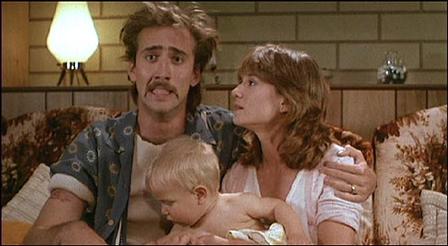
What Makes Raising Arizona Work?
FAIR VALUE of Raising Arizona: $8.00. Like contemporaries A Fish Called Wanda or Brain Donors, Raising Arizona is a relentless slapstick comedy that has high re-watchability.
THE COEN BROTHERS BEGIN HONING THEIR CHOPS: In many ways, Raising Arizona is the wooliest, most slapdash of all of the Coen comedies. They have a clear idea of what they’re trying to accomplish, and the structure of the formula, but they haven’t refined their absurdism to the levels that will later be seen in The Big Lebowski and Burn After Reading. So let’s talk about the Coen formula:
- A Feckless and miscreant but ultimately worthy protagonist. Here, it’s H.I. McDunnogh (Nicholas Cage), a recidivist minor felon who somehow hooks up with Ed (Holly Hunter), a Maricopa county policewoman.
- Even dumber accomplices who serve as the voice of the unreasonable. John Goodman (a Coen mainstay) and Gale (Sam McMurray) are the other three stooges that round out HI’s gang of criminal incompetents, constantly tempting HI towards criminality.
- A dark figure of doom who is ultimately reckoned with at the film’s end. Leonard Smalls (Tex Cobb), who is an absurdly macho road warrior bounty hunter.
- A benedictory figure that provides the moral or the resolution of the film. Nathan Arizona (Trey Wilson).

Raising Arizona has a roughly four act structure- an extended introduction that establishes the premise, the heist/instigating incident, the protagonist nadir, and the climax/resolution of the film.
That’s the bones of the film. But what’s the skin, the comedy, the flavor that makes Raising Arizona quotable and enjoyable? Partly, it’s the Coen brothers exploiting the incongruity of simple characters using elaborate and high-faluting verbiage. Partly, it lays in the characterization of the cast- the running gag of everybody taking Dr. Spock’s child-raising book, for example. There are no sages or wise men in this comedy, only frail, vain, and petty people that represent proxies for how we perceive neighbors and members of our own communities. It’s the combination of absurd decisions with familiar characters that make the Coen comedies work.

Surrealism: The shot of Glen (Goodman) and Gale emerging from the muddy earth, howling at their prison escape, is only the first iconic shot of the film, a sign of the emerging Coen panache for lurid and bizarre iconology. This combines with the numerous location shots of the Arizona landscape, that almost serve to make the film a live action Road Runner cartoon.